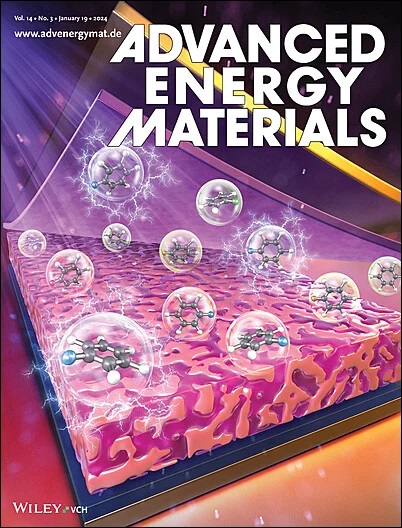Fluorine Passivated Perovskite SrNbO2N Photocatalyst for Robust Sunlight-Driven Water Splitting
IF 24.4
1区 材料科学
Q1 CHEMISTRY, PHYSICAL
引用次数: 0
Abstract
SrNbO2N is a promising narrow-bandgap semiconductor for sunlight-driven water splitting but is generally subject to insufficient photocarrier separation and severe photocorrosion. Here, the targeted single-crystalline SrNbO2N nanobelts are passivated by consecutive annealing in O2 and N2/NH4F to approach the right N/O ratio (1/2) and anion content (O + N = 60 at%). The passivation measures lead to both a low concentration (≈2.2 × 1015 cm−3) of defects including VO, Nb3+, Nb4+ for efficient photocarrier separation and unique fluorine-rich, nitrogen-poor surface with low surface energy for high stability against photocorrosion. Notably, the passivated SrNbO2N nanobelts deliver the highest values of photocurrent density of 4.5 mA cm−2 at 1.23 V versus RHE and stable photocatalytic (PC) Z-scheme overall water splitting activity of ≈10 µmol h−1 H2 evolution under AM 1.5G illumination when used as photoanode materials for photoelectrochemical (PEC) water oxidation and the photocatalytic O2-evolution moiety, respectively. These findings provide not only an effective guideline to upgrade the activity and stability of SrNbO2N but also fresh mechanistic insights into the role of passivation measures.

求助全文
约1分钟内获得全文
求助全文
来源期刊

Advanced Energy Materials
CHEMISTRY, PHYSICAL-ENERGY & FUELS
CiteScore
41.90
自引率
4.00%
发文量
889
审稿时长
1.4 months
期刊介绍:
Established in 2011, Advanced Energy Materials is an international, interdisciplinary, English-language journal that focuses on materials used in energy harvesting, conversion, and storage. It is regarded as a top-quality journal alongside Advanced Materials, Advanced Functional Materials, and Small.
With a 2022 Impact Factor of 27.8, Advanced Energy Materials is considered a prime source for the best energy-related research. The journal covers a wide range of topics in energy-related research, including organic and inorganic photovoltaics, batteries and supercapacitors, fuel cells, hydrogen generation and storage, thermoelectrics, water splitting and photocatalysis, solar fuels and thermosolar power, magnetocalorics, and piezoelectronics.
The readership of Advanced Energy Materials includes materials scientists, chemists, physicists, and engineers in both academia and industry. The journal is indexed in various databases and collections, such as Advanced Technologies & Aerospace Database, FIZ Karlsruhe, INSPEC (IET), Science Citation Index Expanded, Technology Collection, and Web of Science, among others.
文献相关原料
| 公司名称 | 产品信息 | 采购帮参考价格 |
|---|---|---|
| 阿拉丁 |
Nb2O5
|
|
| 阿拉丁 |
Nb2O5
|
|
| 阿拉丁 |
Nb2O5
|
|
| 阿拉丁 |
Nb2O5
|
|
| 阿拉丁 |
KOH
|
|
| 阿拉丁 |
NH4F
|
|
| 阿拉丁 |
KOH
|
|
| 阿拉丁 |
NH4F
|
|
| 阿拉丁 |
SrCO3
|
|
| 阿拉丁 |
SrCO3
|
 求助内容:
求助内容: 应助结果提醒方式:
应助结果提醒方式:


